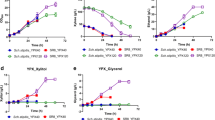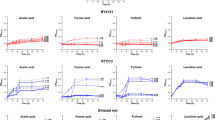Abstract
Cellobiose has garnered attention as an alternative carbon source for numerous biotechnological processes because it is produced when lignocellulosic biomass is treated with endo and exo-glucanases. An engineered Saccharomyces cerevisiae (CEL), expressing cellobiose transporter and intracellular beta-glucosidase utilized cellobiose efficiently. As compared to the culture using glucose, the CEL strain grown on cellobiose produced a similar yield of ethanol with slightly reduced growth rate. In this study, concentrations of central metabolites were monitored at mid-log phase with GC/MS to compare cellobiose- and glucose-grown CEL strain. When the CEL strain was grown on cellobiose, intracellular trehalose concentration increased 6-fold as compared with the glucosegrown cells. Interestingly, the higher level of trehalose in cells grown on cellobiose resulted in physiological changes which might be beneficial for biotechnological processes. We observed higher resistance against oxidative stress when cellobiose was used. Oxidative stress is commonly occurred by the byproducts of pretreatment process of lignocellulosic biomass, such as 2-furaldehyde (furfural) and 5-hydroxymethylfurfural (HMF). Our study demonstrated that intracellular metabolite profiling of yeast strains can be employed for linking intracellular concentrations of metabolite with physiological changes of cells upon genetic and environmental perturbations.
Similar content being viewed by others
References
Hill, J., E. Nelson, D. Tilman, S. Polasky, and D. Tiffany (2006) Environmental, economic, and energetic costs and benefits of biodiesel and ethanol biofuels. Proc. Natl. Acad. Sci. USA. 103: 11206–11210.
Stephanopoulos, G. (2007) Challenges in engineering microbes for biofuels production. Sci. 315: 801–804.
Mosier, N., C. Wyman, B. Dale, R. Elander, Y. Y. Lee, M. Holtzapple, and M. Ladisch (2005) Features of promising technologies for pretreatment of lignocellulosic biomass. Bioresour. Technol. 96: 673–686.
Karhumaa, K., R. Garcia-Sanchez, B. Hahn-Hägerdal, and M. F. Gorwa-Grauslund (2007) Comparison of the xylose reductasexylitol dehydrogenase and the xylose isomerase pathways for xylose fermentation by recombinant Saccharomyces cerevisiae. Microb. Cell. Fact. 6: 5.
Jeffries, T. W. and Y. S. Jin (2004) Metabolic engineering for improved fermentation of pentoses by yeasts. Appl. Microbiol. Biotechnol. 63: 495–509.
Agbor, V. B., N. Cicek, R. Sparling, A. Berlin, and D. B. Levin (2011) Biomass pretreatment: fundamentals toward application. Biotechnol. Adv. 29: 675–685.
Bengtsson, O., B. Hahn-Hägerdal, and M. F. Gorwa-Grauslund (2009) Xylose reductase from Pichia stipitis with altered coenzyme preference improves ethanolic xylose fermentation by recombinant Saccharomyces cerevisiae. Biotechnol. Biofuels. 2: 9.
Matsushika, A., S. Watanabe, T. Kodaki, K. Makino, and S. Sawayama (2008) Bioethanol production from xylose by recombinant Saccharomyces cerevisiae expressing xylose reductase, NADP+-dependent xylitol dehydrogenase, and xylulokinase. J. Biosci. Bioeng. 105: 296–299.
Jin, Y. S., H. Alper, Y. T. Yang, and G. Stephanopoulos (2005) Improvement of xylose uptake and ethanol production in recombinant Saccharomyces cerevisiae through an inverse metabolic engineering approach. Appl. Environ. Microbiol. 71: 8249-8256.
Lu, C. and T. Jeffries (2007) Shuffling of promoters for multiple genes to optimize xylose fermentation in an engineered Saccharomyces cerevisiae strain. Appl. Environ. Microbiol. 73: 6072–6077.
Hamacher, T., J. Becker, M. Gárdonyi, B. Hahn-Hägerdal, and E. Boles (2002) Characterization of the xylose-transporting properties of yeast hexose transporters and their influence on xylose utilization. Microbiol. 148: 2783–2788.
Kim, S. R., J. M. Skerker, W. Kang, A. Lesmana, N. Wei, A. P. Arkin, and Y. S. Jin (2013) Rational and evolutionary engineering approaches uncover a small set of genetic changes efficient for rapid xylose fermentation in Saccharomyces cerevisiae. PLoS ONE 8: e57048.
Kim, J. H., D. E. Block, and D. A. Mills (2010) Simultaneous consumption of pentose and hexose sugars: an optimal microbial phenotype for efficient fermentation of lignocellulosic biomass. Appl. Microbiol. Biotechnol. 88: 1077–1085.
Subtil, T. and E. Boles (2012) Competition between pentoses and glucose during uptake and catabolism in recombinant Saccharomyces cerevisiae. Biotechnol. Biofuels. 5: 14.
Kahar, P., K. Taku, and S. Tanaka (2011) Enhancement of xylose uptake in 2-deoxyglucose tolerant mutant of Saccharomyces cerevisiae. J. Biosci. Bioeng. 111: 557–563.
Li, S., J. Du, J. Sun, J. M. Galazka, N. L. Glass, J. H. Cate, X. Yang, and H. Zhao (2010) Overcoming glucose repression in mixed sugar fermentation by co-expressing a cellobiose transporter and a ß-glucosidase in Saccharomyces cerevisiae. Mol. Biosyst. 6: 2129–2132.
Lynd, L. R., P. J. Weimer, W. H. van Zyl, and I. S. Pretorius (2002) Microbial cellulose utilization: Fundamentals and biotechnology. Microbiol. Mol. Biol. Rev. 66: 506–577.
Ha, S. J., J. M. Galazka, S. R. Kim, J. H. Choi, X. Yang, J. H. Seo, N. L. Glass, J. H. Cate, and Y. S. Jin (2011) Engineered Saccharomyces cerevisiae capable of simultaneous cellobiose and xylose fermentation. Proc. Natl. Acad. Sci. USA. 108: 504–509.
Galazka, J. M., C. Tian, W. T. Beeson, B. Martinez, N. L. Glass, and J. H. Cate (2010) Cellodextrin transport in yeast for improved biofuel production. Sci. 330: 84–86.
Ha, S. J., H. Kim, Y. Lin, M. U. Jang, J. M. Galazka, T. J. Kim, J. H. Cate, and Y. S. Jin (2013) Single amino acid substitutions in HXT2.4 from Scheffersomyces stipitis lead to improved cellobiose fermentation by engineered Saccharomyces cerevisiae. Appl. Environ. Microbiol. 79: 1500–1507.
Eriksen, D. T., P. C. Hsieh, P. Lynn, and H. Zhao (2013) Directed evolution of a cellobiose utilization pathway in Saccharomyces cerevisiae by simultaneously engineering multiple proteins. Microb. Cell. Fact. 12: 61.
Yuan, Y. and H. Zhao (2013) Directed evolution of a highly efficient cellobiose utilizing pathway in an industrial Saccharomyces cerevisiae strain. Biotechnol. Bioeng. 110: 2874–2881.
Jung, J. Y., T. Y. Kim, C. Y. Ng, and M. K. Oh (2012) Characterization of GCY1 in Saccharomyces cerevisiae by metabolic profiling. J. Appl. Microbiol. 113: 1468–1478.
Ryan, D. and K. Robards (2006) Metabolomics: The greatest omics of them all? Anal. Chem. 78: 7954–7958.
Villas-Bôas, S. G., J. Højer-Pedersen, M. Akesson, J. Smedsgaard, and J. Nielsen (2005) Global metabolite analysis of yeast: Evaluation of sample preparation methods. Yeast 22: 1155–1169.
Lange, H. C., M. Eman, G. van Zuijlen, D. Visser, J. C. van Dam, J. Frank, M. J. de Mattos, and J. J. Heijnen (2001) Improved rapid sampling for in vivo kinetics of intracellular metabolites in Saccharomyces cerevisiae. Biotechnol. Bioeng. 75: 406–415.
Gonzalez, B., J. François, and M. Renaud (1997) A rapid and reliable method for metabolite extraction in yeast using boiling buffered ethanol. Yeast. 13: 1347-1355.
Benaroudj, N., D. H. Lee, and A. L. Goldberg (2001) Trehalose accumulation during cellular stress protects cell and cellular proteins from damage by oxygen radicals. J. Biol. Chem. 276: 24261–24267.
Bell, W., W. Sun, S. Hohmann, S. Wera, A. Reinders, C. De Virgilio, A. Wiemken, and J. M. Thevelein (1998) Composition and functional analysis of the Saccharomyces cerevisiae trehalose synthase complex. J. Biol. Chem. 273: 33311–33319.
Henle, E. S. and S. Linn (1997) Formation, prevention, and repair of DNA damage by iron/hydrogen peroxide. J. Biol. Chem. 272: 19095–19098.
Halliwell, B. and J. M. Gutteridge (1984) Oxygen toxicity, oxygen radicals, transition metals and disease. Biochem. J. 219: 1–14.
Zheng, Y., Z. Pan, and R. Zhang (2009) Overview of biomass pretreatment for cellulosic ethanol production. Int. J. Agric & Biol Eng. 2: 51–68.
Klinke, H. B., L. Olsson, A. B. Thomsen, and B. K. Ahring (2003) Potential inhibitors from wet oxidation of wheat straw and their effect on ethanol production of Saccharomyces cerevisiae: Wet oxidation and fermentation by yeast. Biotechnol. Bioeng. 81:738–747.
Klinke, H. B., A. B. Thomsen, and B. K. Ahring (2004) Inhibition of ethanol producing yeast and bacteria by degradation products produced during pretreatment of biomass. Appl. Microbiol. Biotechnol. 66: 10–26.
Palmqvist, E. and B. Hahn-Hägerdal (2000) Fermentation of lignocellulosic hydrolysates. II: Inhibitors and mechanisms of inhibition. Bioresour. Technol. 74: 25–33.
Allen, S. A., W. Clark, J. M. McCaffery, Z. Cai, A. Lanctot, P. J. Slininger, Z. L. Liu, and S. W. Gorsich (2010) Furfural induces reactive oxygen species accumulation and cellular damage in Saccharomyces cerevisiae. Biotechnol. Biofuels. 3: 2.
Author information
Authors and Affiliations
Corresponding author
Rights and permissions
About this article
Cite this article
Kim, TY., Oh, E.J., Jin, YS. et al. Improved resistance against oxidative stress of engineered cellobiose-fermenting Saccharomyces cerevisiae revealed by metabolite profiling. Biotechnol Bioproc E 19, 951–957 (2014). https://doi.org/10.1007/s12257-014-0301-4
Received:
Revised:
Accepted:
Published:
Issue Date:
DOI: https://doi.org/10.1007/s12257-014-0301-4




